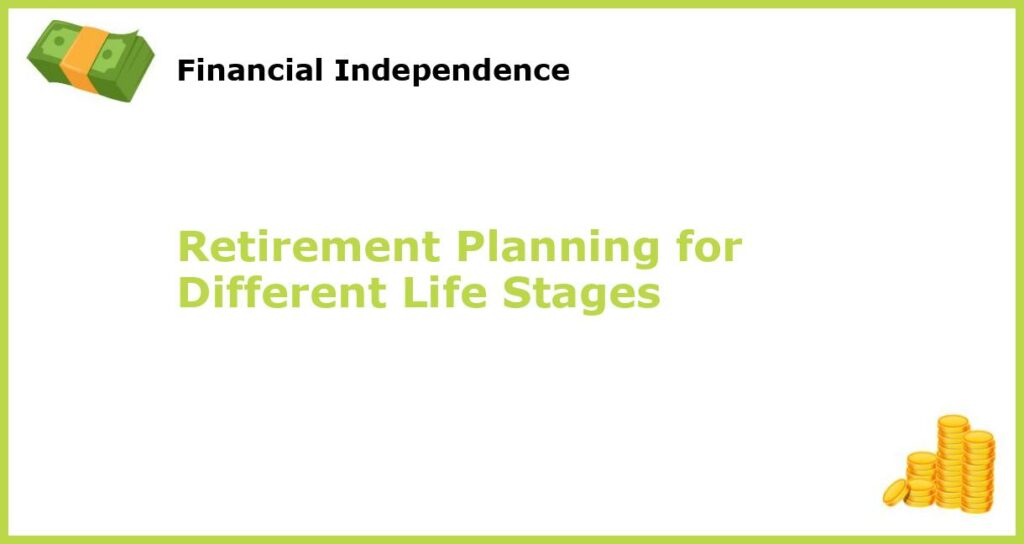They say that time flies when you’re having fun. That may be true, but it also flies when you’re not paying attention to your retirement planning. Retirement may seem like a distant dream when you’re in your 20s, but before you know it, you’re in your 60s and wondering where all the time went. The good news is that it’s never too early or too late to start planning for retirement. In fact, retirement planning is important for people in different life stages for various reasons. In this article, we’ll cover the basics of retirement planning for individuals in different life stages to help you stay on track with your retirement goals.
Planning for Retirement in Your 20s
When you’re in your 20s, retirement may be the last thing on your mind. After all, you’ve just started your career and may have student loans to pay off. However, starting early gives you a head start in the retirement savings game. One of the biggest advantages of starting early is the power of compound interest. Even small contributions can grow into significant amounts over time. For example, if you start saving $100 a month in a retirement account at age 25, you could have almost $450,000 by age 65, assuming a 7% average annual return. Consider investing in a retirement account or setting up automatic savings to take advantage of compound interest.
Planning for Retirement in Your 30s
In your 30s, you’re likely to have more financial responsibilities, such as a mortgage, children, and car payments. While it may be tempting to prioritize other financial goals over retirement savings, it’s important to continue contributing to retirement accounts and reassessing your goals regularly. You may need to adjust your contributions in order to balance retirement savings with other financial priorities. For example, if you get a raise, consider increasing your retirement contributions by a percentage while still allocating funds towards other financial goals.
Planning for Retirement in Your 40s
By your 40s, retirement may be feeling like more of a reality. It’s important to evaluate your current savings and retirement goals to make sure you’re on track. Consider increasing your contributions to retirement accounts and exploring options such as catch-up contributions if you’re behind on savings. Catch-up contributions allow those age 50 or older to contribute more to retirement accounts than younger individuals. Additionally, don’t forget to reassess your investment portfolio to ensure it aligns with your goals and risk tolerance.
Planning for Retirement in Your 50s
As retirement approaches, it’s important to start making final preparations. By your 50s, you should have a solid understanding of your retirement income needs and potential sources of income, such as Social Security and pensions. It’s also a good time to explore options such as long-term care insurance and Medicare supplemental insurance. Long-term care insurance can help cover the costs of care if you become unable to perform activities of daily living, while a Medicare supplemental insurance policy can help fill in gaps in Medicare coverage.
Planning for Retirement in Your 60s
Your 60s may be the decade in which you retire. It’s important to have a clear understanding of your retirement income and expenses before making the decision to retire. If you’re not quite ready to retire, consider options such as phased retirement or working part-time to ease into full retirement. Phased retirement allows you to reduce your hours gradually while maintaining some income and benefits from your employer. Don’t forget to also consider estate planning, such as drafting a will or creating a trust, to ensure your assets are distributed according to your wishes.
Retirement Planning for Those Who Have Retired
Even if you’ve already retired, retirement planning is still important. This may involve reassessing your budget and investment portfolio to ensure you have enough income to last throughout your retirement. Don’t forget to also explore options such as annuities and other retirement income sources that can provide guaranteed income in retirement. An annuity is a financial product that pays out a steady stream of income for a specified period, such as the rest of your life or a set number of years.
Planning for Early Retirement
If you’re considering early retirement, it’s important to thoroughly evaluate your financial situation and retirement goals. Early retirement can impact your retirement income and may require additional savings to bridge the gap until Social Security or pension income kicks in. Consider working with a financial professional to create a plan that ensures your retirement goals are met while minimizing financial risks. Additionally, explore options such as a Roth IRA or taxable investment accounts, which do not have the age restrictions and penalties of traditional retirement accounts.
Planning for Retirement While Self-Employed
As a self-employed individual, retirement planning can be even more important as there are no employer-sponsored retirement plans available. Consider options such as a Solo 401(k) or SEP-IRA to help maximize your retirement savings. A Solo 401(k) is a retirement account for individuals who own a business with no employees, while a SEP-IRA is a retirement plan for self-employed individuals or small business owners with employees. It may also be beneficial to work with a financial professional to evaluate your retirement goals and create a customized plan.
Planning for Retirement While Paying Off Debt
If you’re paying off debt while also saving for retirement, it can be a challenging balancing act. However, it’s important to prioritize both goals. Consider creating a budget that allocates funds towards both goals and exploring options such as refinancing high-interest debt to free up more cash flow for retirement savings. Additionally, consider using windfalls, such as tax refunds or work bonuses, to make extra debt payments or boost retirement savings.
Planning for Retirement While Supporting Adult Children
If you’re supporting adult children while also saving for retirement, it’s important to find a balance. While you may want to support your children, it shouldn’t come at the expense of your own retirement savings. Consider alternatives such as co-signing loans or setting limits on financial support to ensure you’re also meeting your own financial goals. Additionally, encourage your adult children to become financially independent by discussing budgeting and debt management strategies with them.







